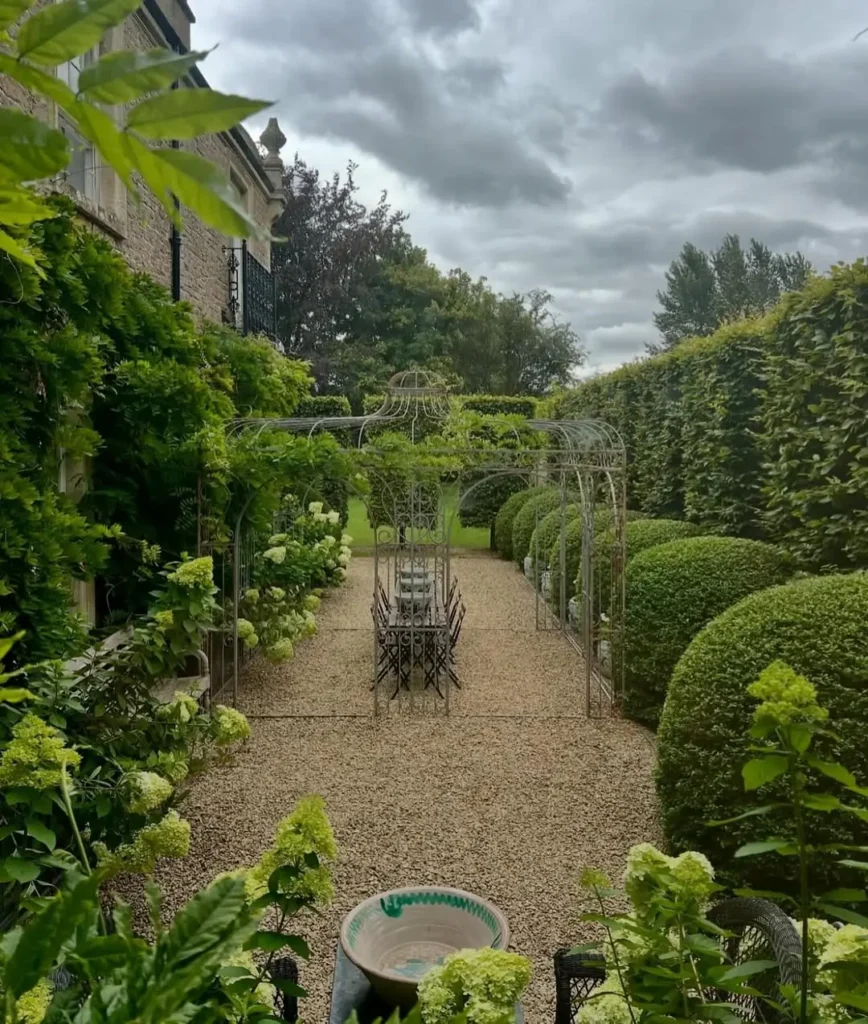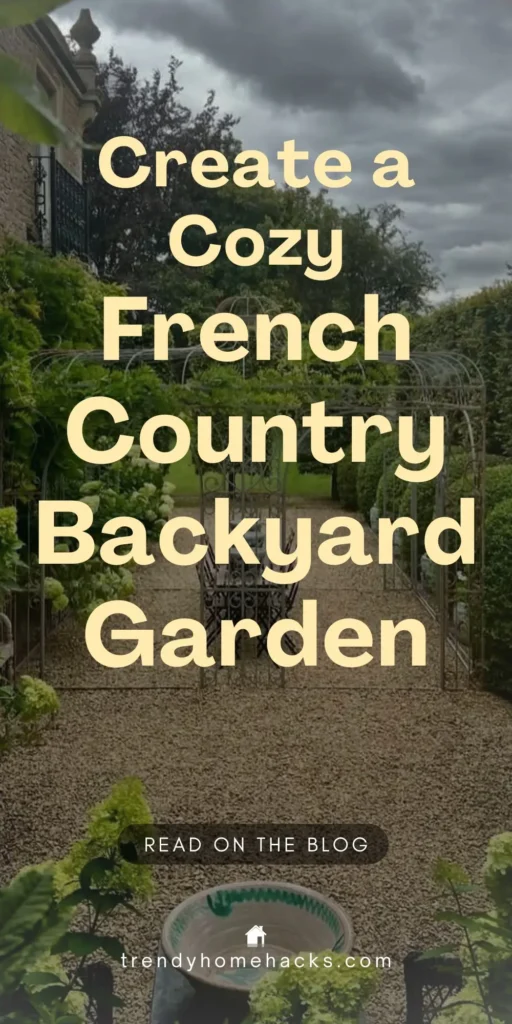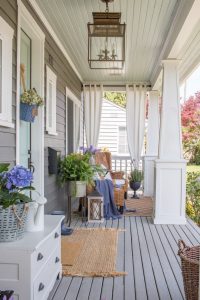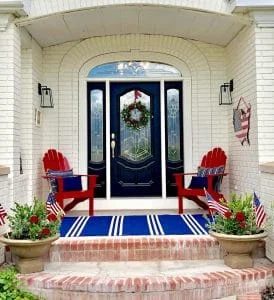If you’ve been dreaming of an outdoor escape full of rustic charm and old-world elegance, “How to Create a Cozy French Country Backyard Garden” is just what you need. This garden style isn’t about rigid lines or perfect symmetry. It’s about slow living, natural textures, and creating a space that feels collected and loved.
A French country garden blends beauty and function. It welcomes you in with soft colors, worn stone paths, and fragrant herbs. It’s a space where you can sip coffee in the morning sun or gather with friends under twinkling lights.
In this post, we’ll walk through how to bring this effortless style to your own backyard. From choosing the right layout to picking french country garden plants that thrive, you’ll find plenty of inspiration here. We’ll also talk about charming outdoor furniture, seasonal decor, and practical tips that make a difference.

Understanding the French Country Garden Aesthetic
Creating a cozy French country backyard garden starts with understanding the heart behind the style. It’s less about perfection and more about charm. A french country garden feels timeworn, layered, and deeply personal.
What Is a French Country Garden?
This garden style draws inspiration from the rolling hills of Provence. Picture old stone walls, gravel paths, and sun-soaked lavender fields. The look is soft, romantic, and grounded in nature.
French country gardens often mix ornamental and edible plants. You’ll see herbs, climbing roses, and fruit trees growing side by side. It’s this mix of function and beauty that makes the space so inviting.
Instead of sharp corners and matching sets, the design embraces imperfection. Vintage furniture, aged pots, and uneven paths all add to the charm.
Characteristics of a French Country Backyard Garden
To create this look, you’ll want to blend structure with wild beauty. That means letting vines sprawl, but also adding a few formal elements like boxwood hedges or a classic fountain.
Gravel paths, terracotta pots, and rustic wood accents are key. So are soft colors—think creamy whites, faded greens, and dusty lavender.
Don’t forget the details. A cozy french country backyard garden often includes vintage finds and meaningful pieces. These are the touches that make it feel personal and lived-in.
For more styling ideas and visuals, check out our guide on how to style your outdoor space with French country charm.
Planning Your French Country Garden Layout
Before you plant a single flower, take time to plan your layout. A thoughtful design helps your french country backyard garden feel welcoming and well-used, not just pretty to look at.
Choosing the Right Garden Location
Start by finding the sunniest spots in your yard. Most french country garden plants love at least six hours of sunlight each day. You’ll also want to think about views from inside your home. Picture what you’ll see through your kitchen window or back door.
Privacy matters too. Use hedges, trellises, or tall potted plants to create cozy, intimate zones. These “garden rooms” offer a feeling of seclusion that makes outdoor spaces more relaxing.
Designing with Structure and Flow
French gardens may look free-spirited, but the best ones have a solid framework underneath. Gravel paths, raised beds, and edging give the space direction without feeling too formal.
Stone walls, weathered fences, and even vintage gates help define areas. Try using symmetry in subtle ways—like placing a bench between two planters—to balance the relaxed planting style.
Must-Have French Country Garden Plants
The heart of any french country garden lies in its plants. These selections bring the softness, fragrance, and timeless beauty that define the look. Think loose, layered plantings and a mix of ornamental and edible varieties.
Signature Flowers and Shrubs
Start with flowers that thrive in sunny, well-drained soil. Lavender is the star of the show—its soothing scent and soft purple blooms are iconic. Pair it with roses in muted pinks or whites for a romantic touch.
Other great options include peonies, delphiniums, and hydrangeas. For structure, try boxwoods or clipped rosemary. Don’t forget climbing plants like wisteria and clematis to add height and drama.
Herbs and Edible Additions
One of the most charming aspects of a french country backyard garden is how it blends practical use with timeless beauty. Fill rustic planters or raised beds with herbs like thyme, sage, chives, and oregano. These not only look charming, but they’re useful in the kitchen too.
If space allows, tuck in vegetables like lettuces, artichokes, or heirloom tomatoes. You can grow these in the same garden beds as flowers for that layered, collected look.
Trees and Natural Shade
To bring a little Provence to your yard, consider adding trees. Olive trees, fig trees, or even cypress lend authenticity and height to your landscape. They also provide gentle shade, perfect for reading nooks or garden benches.
Choosing the right mix of french country garden plants ensures your space is always in bloom and full of life.
Furnishing Your French Country Backyard Garden
Furniture plays a big role in making your french country backyard garden feel like an extension of your home. The right pieces add comfort, character, and that lived-in feeling that defines French country style.
Outdoor Furniture That Fits the Style
Start with natural materials and graceful lines. Wrought iron benches, weathered wood tables, and wicker chairs all work beautifully. Look for pieces that feel timeless, not trendy.
Don’t worry if your furniture looks a little worn. That patina adds charm. Add a few well-loved chairs around a vintage table for casual outdoor dining.
For more outdoor styling ideas, explore these farmhouse patio refresh ideas that blend rustic charm with cozy backyard appeal.
Vintage Finds and Repurposed Pieces
The French countryside is known for flea market treasures. Incorporate antique garden tables, galvanized tubs, and repurposed crates. These pieces add soul to your garden and help tell its story.
Try using an old ladder as a plant stand or a metal basin as a flower planter. Blend old pieces with everyday function to keep the look natural and inviting.
Cozy Textiles and Details
Add softness with outdoor cushions, linen throws, and even a vintage quilt for cooler evenings. Stick to a muted palette—creams, faded blues, or soft grays.
Simple linens and cushions help create a cozy, lived-in feel outdoors. Mix floral prints with simple stripes or checks to bring in that cozy, French farmhouse vibe.
Adding Authentic French Country Garden Decor
Decor is what brings warmth and personality to your french country garden. It’s where charm lives—in the small, meaningful details that make your backyard feel gathered and loved.
Water Features and Stone Accents
Nothing sets the tone like the gentle sound of water. A classic stone fountain or vintage birdbath adds instant romance. If space is limited, try a small tabletop water feature in a quiet garden corner.
Stone urns, terracotta pots, and old troughs also make beautiful focal points. These pieces give weight and history to your space.
Lighting for Ambience
Soft, layered lighting is essential for creating that cozy, lived-in feel. Drape string lights through trees or across a pergola. Place lanterns with candles or soft LEDs along the paths for a gentle, welcoming glow.
You don’t need perfect symmetry—just let the light fall where it feels most inviting. This makes evenings in the garden feel like a scene from the French countryside.
Garden Accessories and Functional Charm
The charm of a french country backyard garden comes from practical items made beautiful. Think aged terracotta pots, wrought iron plant stands, or a weathered wooden potting bench.
Don’t be afraid to show your tools. Hang garden shears, baskets, and watering cans on hooks for both function and style.
A unique way to bring personality into your space is with reclaimed signs or vintage décor. These thoughtful touches tell a story and create a space that feels distinctly yours.
Seasonal Touches for Year-Round French Country Charm
A cozy french country garden isn’t just for spring and summer. With a few simple changes, you can keep that charm going all year long.
Spring and Summer Planting Ideas
In spring, focus on layering your garden with soft color and texture. Plant lavender, peonies, and climbing roses near pathways or garden arches. Mix in herbs like chives, parsley, and thyme for a functional flourish.
Potted topiaries, galvanized tubs with seasonal blooms, and linen-covered outdoor tables give your garden life and character during the warmer months.
As summer arrives, fill bare spots with annuals like cosmos, nasturtiums, or zinnias. Keep the look informal—like your garden has grown in over time.
Fall and Winter Enhancements
When the weather cools, shift your decor to include warmth and texture. Add outdoor lanterns with battery candles or hang string lights with a soft, amber glow.
Fall is a great time to plant mums, ornamental kale, and pansies for seasonal color. You can also use vintage crates to display pumpkins or dried floral arrangements.
In winter, focus on evergreens, pinecones, and weathered iron. If you live in a snowy climate, let your garden decor peek through the frost—aged stone and wood gain even more character this time of year.
Looking for more ideas to refresh your space with the seasons? You’ll love these inspiration tips for a spring backyard refresh that pairs beautifully with cottage and farmhouse styles.
DIY Ideas for a Personalized French Country Garden
Part of the charm in a french country backyard garden comes from making it your own. These small, creative DIY touches bring warmth and meaning to the space—without a big budget.
Handmade Garden Markers and Signs
Crafting your own garden markers is a simple way to add personality. Try painting plant names on stones or stamping them onto metal spoons. You can also use salvaged wood to create rustic signs with sweet messages or herb labels.
These little details add a layer of story to your garden. They show that this space is cared for and thoughtfully designed.
Recycled and Upcycled Garden Projects
The French country style thrives on repurposed beauty. Turn an old ladder into a tiered plant stand. Use vintage teacups as planters or hang an antique window frame as outdoor wall art.
Even everyday items—like watering cans, wooden crates, or enamel bowls—can be reimagined. For more inspiration, explore these creative porch vignette ideas you can also adapt for garden decor.
You might also enjoy ideas on styling outdoor spaces with vintage furniture for a relaxed, cozy feel.
Don’t be afraid to experiment. Part of the joy in this style is embracing imperfection and enjoying the process as much as the result.
Everyday Care Tips for a Cozy French Country Garden
A cozy french country garden is all about natural beauty, but that doesn’t mean it’s carefree. With a little regular upkeep, your garden will stay lush, charming, and full of life all year long.
Caring for French Country Garden Plants
The good news? These plants tend to be hardy, thriving with minimal attention. Lavender, rosemary, and sage thrive with minimal fuss. Deadhead spent blooms to encourage more flowers. Prune shrubs and vines in early spring or late fall to keep them healthy.
Mulching is key. It helps lock in moisture and keeps weeds from taking over during the summer. Choose natural mulch, like bark or straw, to stay in line with the rustic aesthetic.
Eco-Friendly Practices for a Sustainable Garden
French country gardens are rooted in tradition—and sustainability is a big part of that. Compost your kitchen scraps and fallen leaves to create rich, natural fertilizer. Collect rainwater in barrels to hydrate your plants with less waste.
Invite pollinators like bees and butterflies by planting lavender, coneflowers, and other nectar-rich blooms. These small efforts support both your garden and the environment.
A garden that’s well cared for not only looks good—it also gives back. With just a few mindful habits, your outdoor space will flourish for seasons to come.
Conclusion
A french country backyard garden is about more than just pretty flowers. It’s a place to slow down, savor the outdoors, and create something meaningful.
Start simple. Use layered plantings, vintage accents, and cozy seating to build a space that feels lived-in and loved. Don’t rush the process—let your garden grow and evolve over time.
For more ideas to carry this charming style indoors, check out our ultimate guide to French country home decor.
Happy designing!
Frequently Asked Questions about Creating a Cozy French Country Backyard Garden
What is the best time of year to start a French country garden?
The ideal time to start your french country garden is in early spring. This allows you to plant perennials, herbs, and shrubs before the heat of summer arrives. If you’re planning to include roses or lavender, planting them in spring gives their roots time to settle. Fall is also a great time for planting trees, bulbs, and hardy shrubs, especially in warmer climates.
Can I create a French country garden in a small space?
Absolutely. French country gardens are perfect for small backyards, patios, and even balconies. Focus on vertical elements like climbing plants, wall-mounted trellises, and hanging baskets. Choose a few statement pieces—like a vintage bistro set or a rustic planter—to anchor the space. Add soft textiles and layered greenery to create a cozy, romantic feel even in tight spots.
What’s the difference between French country and English cottage garden styles?
Both styles embrace natural beauty and informality, but there are key differences. A french country garden often features Mediterranean plants, warm neutral colors, and a mix of ornamental and edible elements. It has a sun-washed, earthy look with a focus on structure and symmetry in subtle ways.
In contrast, an English cottage garden is typically more lush and colorful, with dense plantings, curved borders, and an explosion of blooms. The look is charmingly chaotic, whereas French country is a bit more restrained and timeless.
Are there low-maintenance plant options for this garden style?
Yes! Many french country garden plants are hardy and require little attention. Lavender, rosemary, thyme, and sage are drought-tolerant and thrive in sunny spots. Climbing roses and wisteria may need occasional pruning but are otherwise easygoing. Consider adding perennial favorites like salvia, yarrow, and catmint—they’ll return each year with minimal effort.
Save this post as a pin for later!




